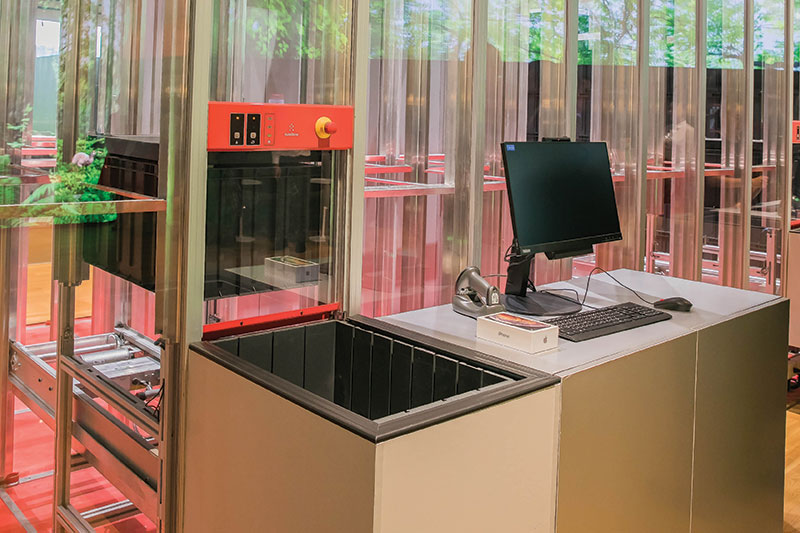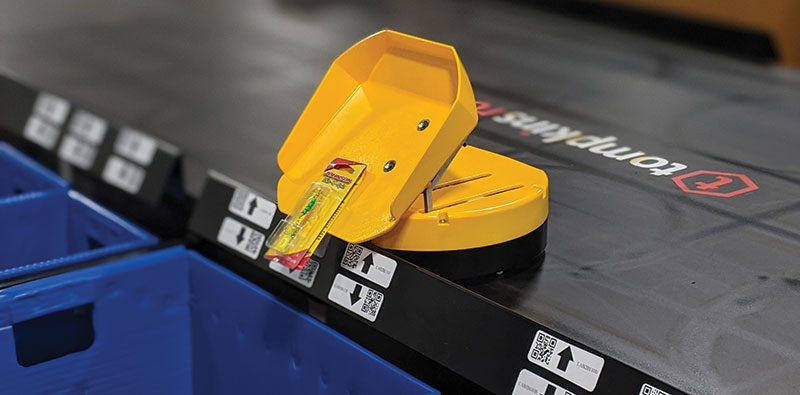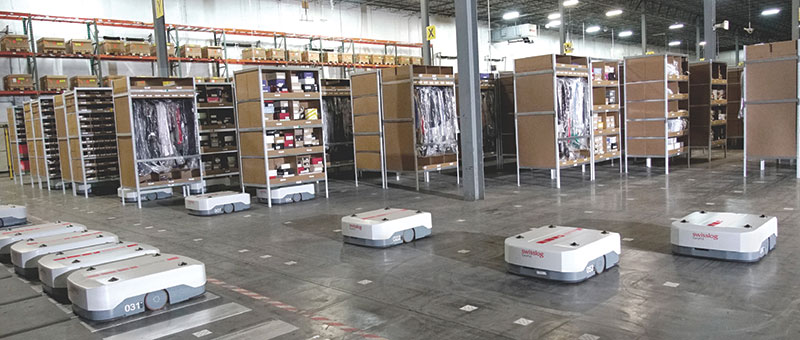Getting to hyperlocal, fast
In e-grocery, automated micro-fulfillment centers are catching on, but for general retailers and e-commerce sellers, other approaches are part of the picture. Providers are focused on helping online brands or other retail merchants quickly establish the network reach they need for next-day or two-day fulfillment.

Micro-fulfillment is on everyone’s lips these days, or so it seems. Major supermarket chains including Kroger, Walmart and H-E-B have started micro-fulfillment center (MFC) projects, tapping automation companies that offer robotic, high-density storage and picking systems, which can be placed inside of a store, or in a so-called “dark store” that fulfills online orders for a compact geographic area.
But for all the attention on the MFC trend, to date, it’s mainly taking hold in grocery. It does, however, overlap with the concept of hyper-local fulfillment, which almost every retailer or e-commerce brand is trying to achieve in some form. The “hyper-local” concept overlaps with other fulfillment network approaches when the aim is enabling next-day or two-day deliveries, including providers of technology-driven warehousing services, also known as “on-demand” warehousing.
Micro-fulfillment and on-demand warehousing aren’t the same thing, but they do both address the need to meet consumer expectations for rapid online order fulfillment.
Micro-fulfillment can be thought of as putting advanced automation right into the back of stores or in dark stores to rapidly meet the need for same-day fulfillment, especially in the grocery sector. Whether it will gain much traction outside of grocery remains to be seen.
In e-grocery, there are some unique order and service level requirements. Online shoppers typically want same-day home or curbside delivery for groceries, and you may have 40 items in a customer order, which is higher than in most other retail segments. By contrast, consumers may be fine with one- or two-day delivery for many other types of goods, though expectations tend to be rising.
On-demand fulfillment network providers do offer technology, especially software tools that help determine where to hold inventory and in what quantities. If the goal is to get online retail orders to customer concentrations quickly, without worrying about building out fulfillment infrastructure, these providers are a part of the picture.
More than 3PLs
Companies offering warehousing on-demand or Cloud logistics networks vary in focus, but they are more than a loose combination of third-party logistics (3PL) warehouses, since they typically offer Cloud-based software that helps manage inventory levels, inventory positioning and other aspects of order fulfillment activity for the merchants.
While traditional 3PLs are a proven way to expand fulfillment reach, with a technology-driven logistics network, there is no need to make arrangements with multiple 3PLs to achieve the needed reach, saysSean Henry, CEO and co-founder ofStord, a Cloud-based, distributed logistics network provider that works with warehouse partners to offer more than 400 facilities to e-commerce brands or to retailers looking to position goods close to customer concentrations.

Autonomous mobile robots that can do sortation are another automation option for micro-fulfillment center projects.
“If you look at traditional 3PLs, they are constrained to the buildings they own or operate and their tech stack,” Henry says. “The constraint there for the retailers or brands is that if you need dozens of warehouses across the country, close to your end consumers. In this case, you’re trying to piece together how to work with multiple 3PLs, and how to distribute your volume across them, given different pricing or different minimum commitments you have with them. And you’re also trying to figure out the tech stack issues at the same time, integrating your e-commerce channels and inventory data across 10 or 20 warehouses run by different partners.”
With Stord’s network, Henry adds, one point of integration exists for the retailer or e-commerce seller, plus supply chain software that can be used to rebalance inventory within the nodes being used. Stord’s software also provides distributed order management and order allocation logic to decide which of the nodes in the Stord network, or combination of nodes, is best to fill incoming orders. Stord also has carriers in its network to facilitate delivery.
“We overlay our network with software that acts like an operating system for our customers and their distribution,” Henry says. “This operating system is a distributed inventory and order orchestration system for deciding how to optimally place specific SKUs across the nodes in their network, and how to optimally route the orders against the inventory. We’re showing [the merchants] their real-time inventory levels across all the nodes that they have with Stord, but also giving them active advice about how to rebalance that inventory, and how to achieve optimal service levels for their customers, and reduce their transportation costs based on where that inventory is being ordered from most.”
Providers of warehousing on-demand have differing models. While Stord partners with smaller and regional 3PLs for sites, others are building out their own warehouses.ShipBob, for example, describes itself as a tech-driven 3PL, but also as a Cloud-based logistics platform designed for small and medium-sized businesses to provide rapid fulfillment capabilities.
According toDivey Gulati, co-founder ofShipBob, the company currently has a network of 16 of its own fulfillment centers and is adding about one DC per month. The sites use ShipBob’s own custom-developed warehouse management system (WMS), and software that the retailers or digital brands can use to gain insight on inventory trends and fulfillment performance. “Essentially, we provide them with a source of truth for their orders and their inventory, based on our software capabilities,” says Gulati.
ShipBob的许多客户电子商务品牌who don’t have stores and have contractors who make their products. Such brands typically use e-commerce software from vendors like Shopify or Big Commerce, but don’t want to get into the business of building out their own distribution network or managing multiple 3PLs. They do want analytics and insight into inventory strategy and how that matches up with their demand patterns, however, says Gulati.
Micro-fulfillment vs. hyper-local fulfillment
The term micro-fulfillment can be thought of as an emerging trend in grocery where you set up automated micro-fulfillment centers (MFCs), typically in the back of a store or attached to it.
The concept of “dark store” functions as an automated MFC to serve a ring of nearby consumers and non-automated stores. The automation for MFCs typically uses robotic, high-density storage and picking systems, offered by several startups, as well as some major warehouse automation providers.
The MFC market has high growth potential, according to analyst firm Logistics IQ. Their MFC market study pegs the market as reaching $10 billion by 2026, growing at a compound annual growth rate of 60% between 2020 and 2026.
Grocery is going to be the main contributor for this market, according to Logistics IQ, although general merchandise and other industries may pursue the model. Logistics IQ finds that MFC automation typically ranges between 5,000 to 25,000 square feet of space.
To date, several major grocery retailers have deployed a handful of automated MFCs, though some have aggressive plans for more, including Walmart, which announced in January 2021 it would be deploying “dozens” of what it calls “market fulfillment centers,” tapping various technology partners, including Alert Innovation, Dematic and Fabric.
Outside of grocery, automated MFCs are more rare. In Tel Aviv, Israel, MFC solution provider Fabric runs an automated MFC for Super-pharm, a drugstore chain and health and beauty retailer, using Fabric’s automation, and
Fabric also recently announced a second MFC project with Super-pharm. In Thailand, Swisslog has deployed a smallAutoStoresolution for TRUE, a mobile network provider, inside of a branding shop in Bangkok.
Hyper-local is a somewhat broader term centering on the need to position inventory very close to customer concentrations for rapid fulfillment. If the aim of a merchant is to quickly establish fulfillment reach, and enable one- or two-day deliveries, that brings in other trends like providers of on-demand warehousing services.
Think of the service-level needed as a key demarcation point. Hyper-local fulfillment with a same-day service goal is essentially the same as the micro-fulfillment concept.
“They can monitor order fulfillment trends and how much inventory they have left, and also benefit from analytics,” says Gulati. “With our analytics, they can see where their customers are, and then the software recommends the best fulfillment center locations for them to use in our network to optimize for both transit time and cost.”
Within ShipBob’s network, its DCs are not heavily automated, though software technology and wireless handhelds are used to direct picking, packing and shipping activities. “We are super heavy on the use of software and analytics,” says Gulati. “We wanted to focus on software capabilities first, because we’re expanding so fast.”
Ware2Go,提供按需实现和正式ing, also layers software functionality into its services to benefit the merchants and online brands who use it, as well as to help the warehouse partners who carry out the fulfillment. This software platform is called FulfillmentVu, and it combines warehouse management, order management and transportation management system functions. The company, part of UPS, also recently announced a free app called NetworkVu, which analyzes a merchant’s sales and transit data using machine learning to recommend ideal warehouse placements to maximize delivery speeds within ground networks.
第二天的商人寻求可靠地实现or two day, and to be able to fine tune inventories, such software-driven insights will help with customer satisfaction and their bottom line, explains Patrick Cadic, chief revenue officer (CRO) for Ware2Go.
“We help [merchants] with insights into their fulfillment processes, and that can improve their unit level economics, but the larger benefit is how the platform ensures a consistent level of customer experience, and consistent outcomes, for their customers,” says Cadic. “That is where the real value comes in.”
Mall-based hubs
A different sort of platform for retail fulfillment has emerged that leverages unused space in shopping malls for a variety of fulfillment services.Fillogicbills itself as a logistics-as-a-service platform for retail. The company places “micro-hubs” within mall properties to perform a variety of logistics services, mainly using technology such as WMS to direct efficient and accurate pick and pack, but foregoing the type of high-density MFC automation beginning to catch on in the grocery sector.

Mobile goods-to-person robotics with configurable storage shelves are a possible solution for micro-fulfillment.
“We take under-utilized space at shopping malls, not every shopping mall, but with the right shopping mall partners, and convert them into tech-enabled micro distribution hubs,” says Bill Thayer, co-founder and co-CEO of Fillogic. “We provide a variety of value-added, differentiated services at these locations. E-commerce pick and pack is a big part of what we do right now, but it also includes receiving optimization, forward staging of inventory, outbound shipment optimization and reverse logistics.”
For general retail, which lacks the high units-per-transaction (TPU) found in grocery, having some software capabilities at the hubs to direct work and ensure accuracy makes the most sense, says Thayer, rather than trying to shrink down high-density warehouse automation.
Fillogic, he explains, has developed its own WMS for its hubs, and also has proprietary software for routing and shipping management. These software tools, plus the location of the hubs, are key to the effectiveness of the Fillogic platform, Thayer says, though he doesn’t rule out adding some mobile robotics automation in the future.
“We live in the last mile because we are operating from these shopping malls,” says Thayer. “We are providing retailers with multiple services from the best physical locations, close to the target consumer concentrations everybody wants to reach.”
Most retail stores, says Thayer, weren’t designed to act as mini-DCs for e-commerce fulfillment, so it’s a better idea to create small, technology-enabled fulfillment hubs that can aggregate fulfillment operations and capacity for multiple retailers within the mall. As of April 2021, Fillogic already had eight micro-hubs operating at mall locations in Connecticut, New York, New Jersey and Pennsylvania, with plans to have 30 across the country by the end of this year.
价值不仅来自身体的地区ns of the hubs, but also from the software, Thayer explains. “We call ourselves an operations-enabled technology company,” says Thayer. “The power comes from the connectivity in the software, from the network of hubs we offer, and also from the operations and services we provide. Our perspective is that retail is not dead—it’s just in transformation. That transformation is going to be in flux for a couple of years, but if you have a good technology platform for logistics, and sound operations, you’re going to be much more successful in adapting to how that transformation plays out.”
Automation’s play
The demand side characteristics that make MFC automation attractive in grocery are not found in most other types of retail, notesColman Roche, vice president of e-commerce and retail industries forSwisslog, which provides MFC automation, including for supermarket chain H.E.B. For one thing, most consumers need groceries once or twice a week, versus goods like apparel or home electronics that are bought less frequently.
另一个巨大的差异,增加了罗氏公司,是在grocery, the typical number of units per customer order ranges between 28 to 38 items, and many consumers want same-day curbside or home delivery for groceries.
罗氏表示,尽管一般零售商也有a strong interest in being able to fill online orders quickly and efficiently, most non-grocery retail outlets don’t have the order characteristics found at big supermarkets, making MFC automation within retail shops a tougher proposition to justify. “The sheer quantities in terms of number of lines per typical order, is vastly higher in grocery than with your typical online order,” says Roche. “There are just some striking differences between grocery and non-grocery that influence why grocers are moving first with micro-fulfillment.”
Some mobile robotics goods-to-person automation is well suited to facilities with low ceiling and odd-sized, larger products like coats or other bigger apparel items, says Roche. For example, Swisslog offers a system calledCarryPickthat uses mobile robots that transport mobile storage units to a picking station. The compartments in these racks are configurable, which would allow them to handle odd shaped or bigger items, as well as smaller, more uniform items.
It may be that some business model innovation is what will lead to some MFCs and use of automation for general retail, such as use of smaller metro area fulfillment centers to accelerate rapid fulfillment of online retail orders, either to homes or nearby stores.
Small fulfillment centers in shopping malls could create the volume of picking activity that makes MFC automation attractive. In Thailand, Swisslog has deployed a small (500 bin) AutoStore system for TRUE, a telecommunications and mobile network provider, inside of a branding shop in a high-end shopping mall in Bangkok, to store and pick goods for customers buying mobile phones or accessories.
In the grocery sector, Swisslog has deployed AutoStore solutions that are smaller than those found in larger DCs, but that still might hold 12,000 SKUs, or as many as 30,000 SKUs, with some MFCs filling 3,000 customer orders a week, and others are capable of more filling more than 30,000 customer orders per week.
Whether general retailers will jump into MFCs and MFC automation remains to be seen, but just like grocery, MFC automation needs to be justified by dramatically faster, more efficient picking than could be done manually, with other benefits like freeing up store aisle space for in-store shoppers, rather than disrupting the store experience with a bunch of workers trying to fill online orders from shelves.
“I think the whole retail industry is watching what is happening in grocery with micro-fulfillment and trying to learn as much as possible from that,” says Roche.
Steve Simonson, a vice president at Tompkins Solutions, agrees that in grocery, MFC automation makes sense for some stores or locations because of order complexity, volumes and service level requirements in grocery orders, but that for general retail, MFC automation can be a stretch, since shoppers sometimes only buy a couple of items.
“If the volumes aren’t there, the automation may not make sense,” Simonson says, adding that if there was a more hub-and-spoke model or a large retail store with enough volume, MFC automation might bring payback.
Tompkins Robotics, a sister company to Tompkins, offers its t-Sort mobile robotic sortation solution for MFCs. However, even if a small retail store doesn’t have the volume for such automation, says Simonson, a retailer could outfit a regional DC with a t-Sort solution to sort each-level items for store replenishment, or to support direct-to-consumer order fulfillment.
In regional DCs, mobile robotic sortation has enough “many to one” sorting volumes to bring rapid payback and efficiently replenish stores at the item level for goods like health and beauty products, hardware items, or many other goods that are labor intensive to sort manually.
Even if a retailer finds its stores don’t call for MFC automation, the same type of robotics could help with the ultimate aim of faster fulfillment by being leveraged at regional DCs, many of which struggle in finding enough labor, says Simonson.
“The warehouse industry is starved for employees,” Simonson says. “The average wage rate is going up, and it is just very difficult to fill those open positions, so companies are addressing this need by using automation. That is the bigger trend we are seeing a lot of in retail distribution.”

Article Topics
Latest in Logistics
Saddle Creek Logistics Services heralds warehouse expansion in four U.S markets Union Pacific expands intermodal service out of Port Houston Penske Logistics is taking steps to expand its freight brokerage operations U.S. rail carload and intermodal volumes are mixed, for week ending May 27, reports AAR Manufacturing declines for the seventh straight month in May, reports ISM Tentative FedEx Express union pilots deal is a positive sign for progress CEO outlook: Optimism, and caution, pave the road ahead in Boston Consulting Group survey More LogisticsAbout the Author
Subscribe to Logistics Management Magazine

Find out what the world's most innovative companies are doing to improve productivity in their plants and distribution centers.
Start your FREE subscription today.
May 2023
万博2.0app下载

Latest Resources














